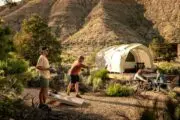
A lot has happened within the Greater Toronto new construction industry over recent months, between increasingly higher construction costs to near-record condo sales.
Another big change has also transpired — Freed Developments has a new president.
In September, the Toronto-based developer welcomed Jane Renwick as the president. With a career encompassing many roles in residential sales, research and development, Renwick has worked in leadership roles with several big-name GTA brands including vice-president of sales and marketing at Diamond Kilmer Developments and executive vice-president of Urbanation.
Within the same month of Renwick’s appointment as president, Freed Developments purchased some of Ontario’s most notable resort properties — inclusive of Horseshoe Valley Resort, Deerhurst Resort and development lands at Blue Mountain Resort — from Skyline Investments Inc. in a $300-million deal. The acquisition will be a crucial component of Renwick’s new role and the future of Freed Developments.
Livabl spoke with Renwick to learn more about her first couple of months at Freed Developments and some of the new construction trends that have played out in the GTA.
You have an extensive history working in Toronto real estate and residential development, from Urbanation to Onni Group. How did you get into the real estate industry?
Back in my twenties, I met Jeanhy Shim, who was running Urbanation at the time. Jeanhy would hire my roommates and I to “site shop” and do resale data entry on the weekends for Urbanation’s quarterly report. While doing that, I bought my first condo, renovated it and sold it. Then one of my sisters and I bought a house in Roncesvalles, we renovated it and sold it. I had clearly caught the real estate bug, which ultimately led to my first job as a research analyst at Urbanation.
Before Freed Developments, you were working at Diamond Kilmer Developments as the vice-president of marketing and sales. Tell me about that role and what were some of the things you did during your time there. Are there any notable projects or accomplishments that you’re particularly proud of?
DiamondCorp and Kilmer Group have been partners in various projects over the years. Diamond Kilmer Developments is a formalization of that partnership with a “Missing Middle” or midrise mandate. While I was there our goal was to acquire brownfield sites with access to transit in established or transitioning neighbourhoods. Reunion Crossing was our first project, an 11-storey mid-rise project with 96 stacked townhomes – 20 of which are being developed in partnership with Habitat for Humanity. The city loved what was proposed for that site, including a small city park with a splash pad. It’s under-construction and will be a wonderful community once it’s complete. I like neighbourhood-scaled development – it’s not easy, but there’s a place for it in our growing city.

Freed prides itself on “design-based development.” What does that mandate mean to you? How do you plan to create and foster design-based development as president?
I love looking at the Freed portfolio of completed projects. I think they stand out when you compare them to what other Toronto developers have delivered. I’m excited to build on and contribute to this growing portfolio of iconic, hospitality infused projects. We are certainly committed to design excellence, inside and out, and are always looking to work with architects, both locally and internationally who are aligned with Freed’s clean, modern, often playful, aesthetic.
In the same month that you became president, Freed Developments acquired Deerhurst Resort, Horseshoe Valley Resort and development lands at Blue Mountain in a multi-million dollar deal. How do you think Freed’s involvement will reinvent “up North” in Ontario?
I’m not sure “up North” needs to be reinvented, but there’s certainly room to expand upon the offering to include more modern design. You could argue that it’s missing the cool-factor that Freed will inevitably bring to these classic properties, both from a real estate development and hospitality perspective. Deerhurst is 125 years old this year, and that longevity deserves respect. The future juxtaposition of classic and modern architecture, set against a gorgeous northern Ontario landscape is very exciting to me.

It’s been an interesting year and a half for real estate in general, and also new construction, with the events of the pandemic. What trends from this time stand out to you?
I think this industry has been extremely fortunate throughout COVID. We have been as busy as ever from planning and approvals, to sales and construction. The market appears to be insatiable. We are continually hitting new highs in the downtown condo market from a price per square foot basis, which has had a ripple effect on the ‘905’ – a market that continues to gain a greater share of medium and high-density development within the GTHA. I believe that as long as the low-rise market continues to have a relatively high barrier to entry, the multi-res market across the GTHA has room to play.
Everyone has had to use technology and digital tools more over the last two years than ever before. How do you see technology becoming a more central part of selling, marketing and designing new construction real estate?
Electronic deal signing has taken over. I don’t think we’ll ever go back to writing or physically pulling together a deal – with or without a presentation centre. That seems so antiquated at this point. Renderings have always played a huge role in selling new construction projects. They’re getting even more photo-realistic, which is incredible. Video is also becoming a must. I think we’re doing a better job of storytelling and communicating what buildings, suites and amenities will actually look like, which helps to de-risk the “buying off plan” sales process. Throughout COVID, we have been creating virtual sales environments with the adoption of technology in design, marketing and sales. I don’t think we’ll ever go back to building large, traditional presentation centres.

New home supply is an important topic right now, and also was during the recent federal election. Where do you see housing growth and expansion happening in the next few years?
I believe that housing growth will continue throughout the GTHA and beyond the greenbelt, as long as strong immigration persists. I don’t think downtown is dead by any stretch, which dominated the conversation during Covid, but I do think a lack of affordability has forced buyers to look at other urban, or urban-suburban areas over the past couple of years. I don’t see this trend changing, which will put supply and affordability pressures on the periphery markets as well.
Under your leadership, where do you hope to take Freed Developments? What’s next for the company?
The resort portfolio acquisition is a huge component and is probably what has dominated the first six weeks of my time at Freed, but there’s still an urban portfolio. We have two sites, one at Duncan and Adelaide, and another one on Eglinton [Avenue East] and the Don Valley Parkway. It is my goal to keep all the balls in the air and for things to be moving at a speed that is conducive to the bottom line. I want to continue to serve the market and get great projects out there, both in the urban and resort markets. I think this is the most creative and strategic I’ve had to be in my career – this is a time of tremendous opportunity for me, Peter and the Freed team.






